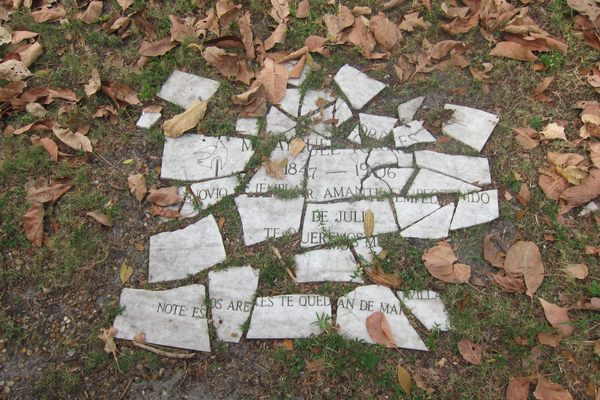Why Some Gravestones Are Shaped Like Tree Stumps
When nature and secret societies get together.

In the bright light of a summer afternoon, Green-Wood Cemetery in Brooklyn is filled with a quiet life. Dark birds flitter and squawk among blocks of granite, black-eyed Susans burst into flower beside catacombs, and fresh-cut grass scents the air. Most of the stately gravestones are shaped into obelisks or headless angels or urns draped with stone cloth. Among these classic markers of memory, though, are surprises—grave markers that simulate the natural world that surrounds them. They are shaped like tree stumps.
Some of Green-Wood’s tree-stump markers take the shape of a cross. Others are simpler, four or five feet tall, with their branch shorn off. One is a short, cleanly cut stump, like one a hiker might rest on during a long walk through the woods. It marks the grave of Alfred Vanderwerken Jr., who died in 1906. “He loved nature,” the marker says.
Tree-stump tombstones like these can be found in graveyards across the country. They tend to surprise people who come across them, since they’re not quite what we expect to see at the head of a grave. They date mostly to 1880s to 1920s, when funerary art in the United States was moving away from the grand mausoleums and obelisks found elsewhere in Green-Wood. The tree-stump stones were part of a movement to turn the focus of death back to life, and they’re a unique form connected with the secret societies of the time. “They qualify as folk art,” writes Susanne Ridlen, in her 1999 book Tree-Stump Tombstones.

Ridlen documents more than 2,400 tree-stump tombstones in Indiana alone. They came at what she calls a transitional period in American funerary art, when cemeteries were emphasizing nature and markers grew more modest. The customs around death were starting to focus more on the deceased’s life and the people left behind, and a tree proved a powerful symbol of both eternity and humanity, recalling the Bible’s tree of life and tree of knowledge.
Ridlen identified many variations: the vertical stump, the double vertical stump, the horizontal stump, the ledger tree stump, the tree-stump bench, the tree-stump chair, the tree-stump cross, the simple tree-stump base. They could be decorated with birds, books, firearms, flowers, plants, anchors, or animals, along with the signs of fraternal orders, from unions to the Elks to the Freemasons.
One organization in particular became associated with tree-stump tombstones, the Woodmen of the World. Formed in Omaha, Nebraska, in 1890, the group served as a life-insurance company at a time when there was little financial security if a family’s breadwinner died. Fraternal societies had started banding together to provide members’ families with a source of income after the death of a member. The Woodmen recruited rural men and prioritized hard work, selflessness, and other values. Its members had axes, and conducted drills with them in uniform, but their “woodcraft” was mostly symbolic, inspired by the image of pioneers clearing out forests to provide for their families.

Initially, the perks of becoming a Woodman included a free tombstone. The Woodmen headquarters created standard designs that it sent to local stonecutters. The tree wasn’t the only option, but given the organization’s name and traditions, it was a very popular choice. Later, the organization changed its policy so that it would only contribute $100 towards a tombstone, and only if it had the Woodmen of the World logo on it.
But Ridlen found the emblems and insignia of many other fraternal organizations on the tree-stump tombstones she examined. At the time, it was also simply a popular design that reflected contemporary attitudes about death and a desire to rejoin nature. Today’s tombstones tend to be modest, and a stone tree stump might seem ornate. In the 21st century, our ideas about joining nature after death have gone a step further. In addition to cremation with scattered ashes, some people choose to be buried without a headstone at all, or with a living tree to mark their final resting place.























Follow us on Twitter to get the latest on the world's hidden wonders.
Like us on Facebook to get the latest on the world's hidden wonders.
Follow us on Twitter Like us on Facebook